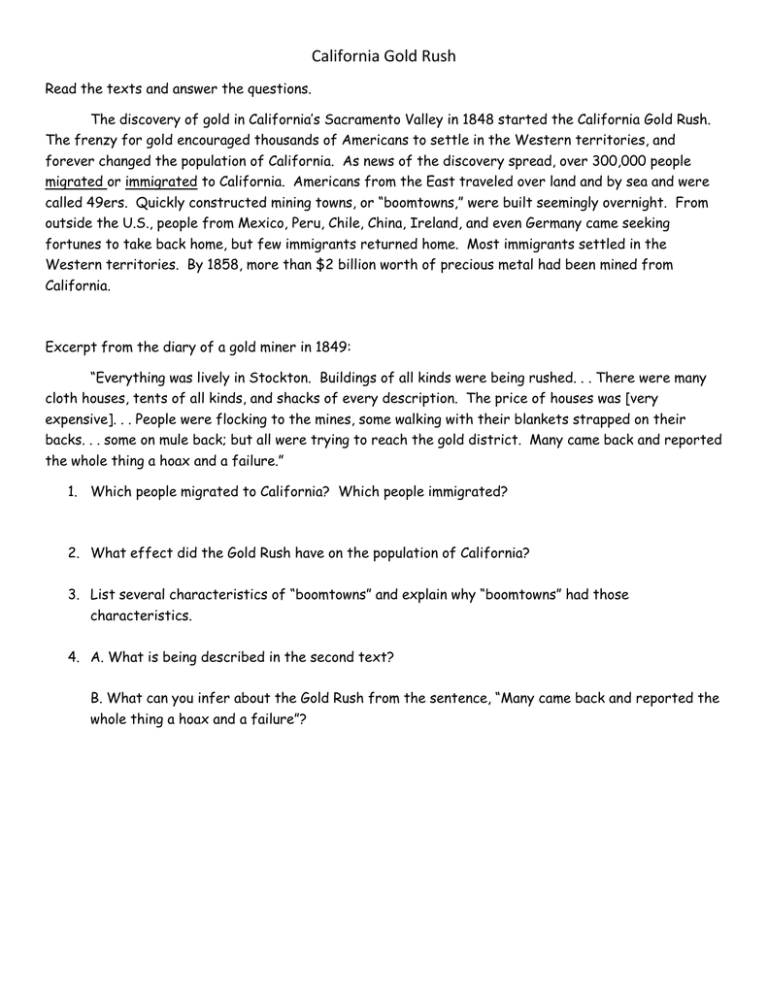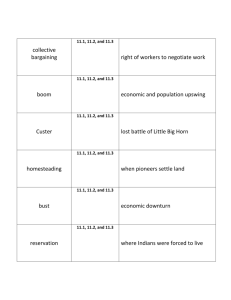California Gold Rush
advertisement

California Gold Rush Read the texts and answer the questions. The discovery of gold in California’s Sacramento Valley in 1848 started the California Gold Rush. The frenzy for gold encouraged thousands of Americans to settle in the Western territories, and forever changed the population of California. As news of the discovery spread, over 300,000 people migrated or immigrated to California. Americans from the East traveled over land and by sea and were called 49ers. Quickly constructed mining towns, or “boomtowns,” were built seemingly overnight. From outside the U.S., people from Mexico, Peru, Chile, China, Ireland, and even Germany came seeking fortunes to take back home, but few immigrants returned home. Most immigrants settled in the Western territories. By 1858, more than $2 billion worth of precious metal had been mined from California. Excerpt from the diary of a gold miner in 1849: “Everything was lively in Stockton. Buildings of all kinds were being rushed. . . There were many cloth houses, tents of all kinds, and shacks of every description. The price of houses was [very expensive]. . . People were flocking to the mines, some walking with their blankets strapped on their backs. . . some on mule back; but all were trying to reach the gold district. Many came back and reported the whole thing a hoax and a failure.” 1. Which people migrated to California? Which people immigrated? 2. What effect did the Gold Rush have on the population of California? 3. List several characteristics of “boomtowns” and explain why “boomtowns” had those characteristics. 4. A. What is being described in the second text? B. What can you infer about the Gold Rush from the sentence, “Many came back and reported the whole thing a hoax and a failure”? Pacific Railroad Act of 1862 Use the text and complete the graphic organizer. By 1850, more than 9,000 miles of railroad tracks connected the states east of the Mississippi River. Railroads enabled interstate trade and created a better network of travel, communication, and business in the East. Travel to the West, however, was still limited. Pioneers braved the risky and difficult six-month journey in covered wagons along the Oregon and California trails. Other fortune-seekers took the six-month journey by boat around South America. President Lincoln encouraged westward expansion. He saw the railroads as an opportunity to greatly improve trade with the West and strengthen the Union. In 1862, Congress passed the Pacific Railroad Act, and President Lincoln signed it into law. This act gave large land grants to railroad companies to build transcontinental railroad from East to West. The Union Pacific Railroad Company began construction in Council Bluffs, Iowa, on the eastern side of the Missouri River, and built west. The Central Pacific Railroad Company began construction in Sacramento, California, and built east. Their goal was to join in the middle. On May 10, 1869, the two railroads joined at Promontory, Utah. Now, the United States was connected by railroad from the Atlantic Ocean to the Pacific Ocean! 1. A. The prefix “inter” means “between.” Use the prefix and the text to define Interstate trade. B. How did the East benefit from interstate railroads in the 1850s? 2. A. What was the purpose of the transcontinental railroad? B. Why was the Pacific Railroad Act necessary? 3. Describe the relationship between the transcontinental railroad and manifest destiny. 4. Predict how the transcontinental railroad affected 2 of the following: A. Wagon Trains – B. Interstate trade – C. Western settlement –


